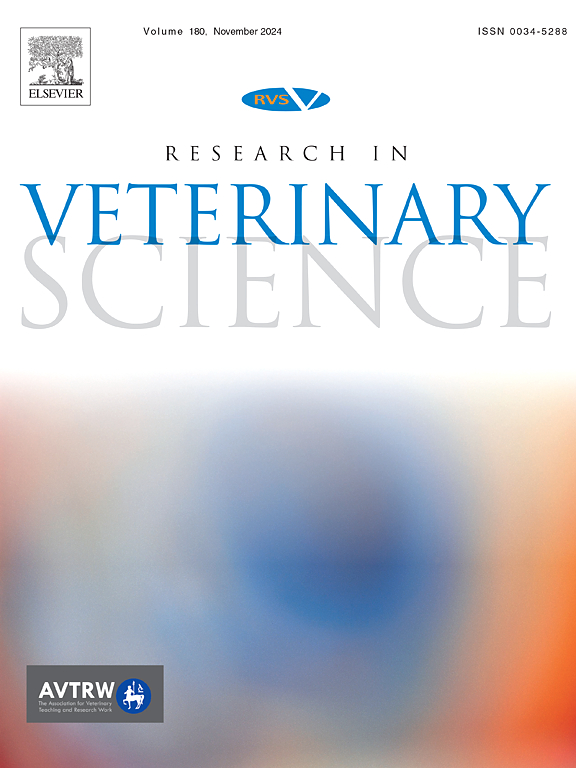在饲养大型反刍动物的小农中与布鲁氏菌感染相关的流行率和群体水平风险因素。
IF 2.2
3区 农林科学
Q1 VETERINARY SCIENCES
引用次数: 0
摘要
布鲁氏菌病是一种向动物和与其密切接触的人(如农民)传播风险较高的疾病。因此,本研究旨在确定巴基斯坦旁遮普省卡苏尔牛布鲁氏菌病的血清患病率和相关危险因素。通过乳环试验(MRT)收集了100个汇集的牛奶样本,这些样本来自100个小农奶牛和水牛混合畜群,研究种群总数为425头动物(277头牛和148头水牛),每个畜群最多有7头动物。从mrt阳性畜群的动物身上采集血液样本,然后进行间接酶联免疫吸附试验(i-ELISA),以检测是否存在抗流产布鲁氏菌的抗体。在100头牛中,16% (n = 16)为mrt阳性。在mrt阳性的牛群中,共有77头动物(43头母牛、3头公牛、21头母水牛和10头公水牛)存在;32只(41.6%)血清呈i-ELISA阳性,其中水牛血清阳性率最高(54.8%),高于奶牛(32.6%)。近38%的农民不知道布鲁氏菌病。畜群水平的危险因素表明,近期流产史和繁殖期间换牛的畜群布鲁氏菌血清阳性升高。相反,有兽医帮助的畜群表现出下降的布鲁氏菌血清阳性。这一发现强调了政府主导的提高认识运动的必要性,强调常规筛查,特别是对繁殖公牛进行筛查,以阻止疾病进一步传播。早期发现和管理可以改善动物健康、牛奶生产和牲畜养殖户的经济福祉。本文章由计算机程序翻译,如有差异,请以英文原文为准。
Prevalence and herd-level risk factors associated with Brucella infection in smallholders keeping large ruminants
Brucellosis is a disease that poses a higher risk of transmission to animals and people who have close interactions with them, such as farmers. Therefore, the present study was designed to determine the seroprevalence of bovine brucellosis and associated risk factors in Kasur, Punjab, Pakistan. One hundred pooled milk samples from 100 smallholder mixed herds of cows and buffaloes with a total study population of 425 animals (277 cattle and 148 buffalos) with a range of up to seven animals in each herd were collected and tested through a milk ring test (MRT). Blood samples were collected from the animals of MRT-positive herds and then subjected to an indirect enzyme-linked immunosorbent assay (i-ELISA) for the presence of antibodies against Brucella abortus. Of the 100 herds, 16 % (n = 16) were MRT-positive. In MRT-positive herds, 77 animals (43 female cattle, three male cattle, 21 female buffaloes, and ten male buffaloes) were present; 32 (41.6 %) were i-ELISA seropositive, with the highest seropositivity (54.8 %) observed in buffaloes as compared to cows (32.6 %). Almost 38 % of the farmers were unaware of brucellosis. Herd-level risk factors indicated Brucella seropositivity increased in herds with recent abortion history and bull exchange during breeding. Conversely, herds with veterinary assistance exhibited a decreased Brucella seropositivity. The findings highlight the need for a government-led awareness campaign emphasizing routine screenings, especially for breeding bulls, to stop further disease spread. Early detection and management can enhance animal health, milk production, and livestock holders' economic well-being.
求助全文
通过发布文献求助,成功后即可免费获取论文全文。
去求助
来源期刊

Research in veterinary science
农林科学-兽医学
CiteScore
4.40
自引率
4.20%
发文量
312
审稿时长
75 days
期刊介绍:
Research in Veterinary Science is an International multi-disciplinary journal publishing original articles, reviews and short communications of a high scientific and ethical standard in all aspects of veterinary and biomedical research.
The primary aim of the journal is to inform veterinary and biomedical scientists of significant advances in veterinary and related research through prompt publication and dissemination. Secondly, the journal aims to provide a general multi-disciplinary forum for discussion and debate of news and issues concerning veterinary science. Thirdly, to promote the dissemination of knowledge to a broader range of professions, globally.
High quality papers on all species of animals are considered, particularly those considered to be of high scientific importance and originality, and with interdisciplinary interest. The journal encourages papers providing results that have clear implications for understanding disease pathogenesis and for the development of control measures or treatments, as well as those dealing with a comparative biomedical approach, which represents a substantial improvement to animal and human health.
Studies without a robust scientific hypothesis or that are preliminary, or of weak originality, as well as negative results, are not appropriate for the journal. Furthermore, observational approaches, case studies or field reports lacking an advancement in general knowledge do not fall within the scope of the journal.
 求助内容:
求助内容: 应助结果提醒方式:
应助结果提醒方式:


